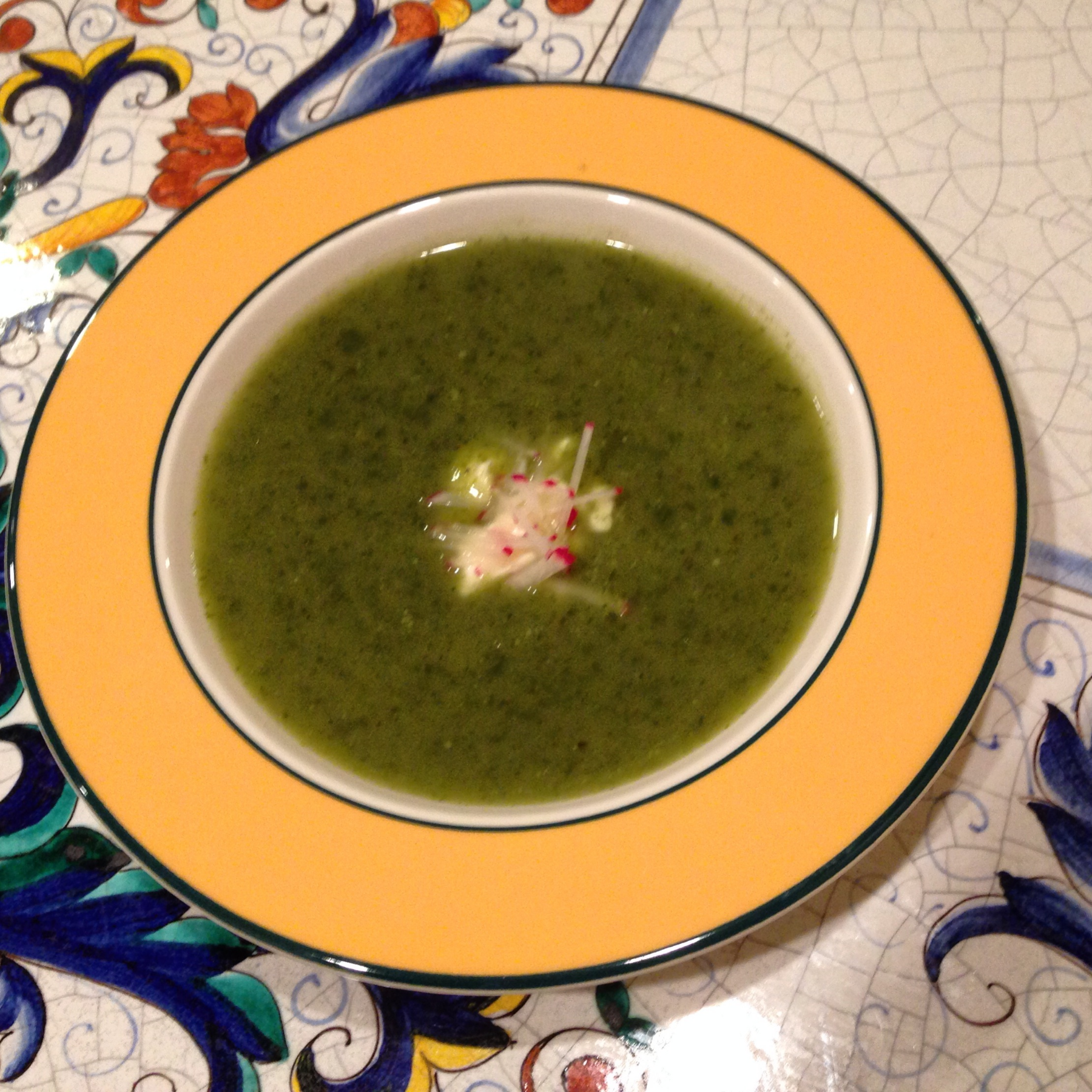This time of year at the farmers’ markets a rainbow of radishes are available. I must admit a fondness for the slender white tipped ones they call French Breakfast radishes. One of my favorite snacks is fresh radishes—add a little crunchy sea salt and some lovely butter and you’ve got an easy delicious snack. What could be more French?
As wonderful as radishes are, I have always lamented having no use for the green stems a.k.a. fronds. That’s where this soup comes in.
The recipe for this springtime soup comes from Damien Delecheneau. He and his wife Coralie make wine at Domaine La Grange Tiphaine in the Montlouis region of the central Loire Valley, just south of Amboise. Normally I recommend making it in very early spring when the radish and carrot fronds are at their most delicate, but I found some lovely tender fronds at the market last week—perfect for this delicious soup.
Radish and Carrot Frond Soup
Ingredients:
1 quart chopped radish fronds
1 cup chopped carrot fronds
1 clove garlic
1 cup diced peeled potatoes
2 quarts water
kosher salt
black pepper, fresh ground
Crème fraiche
Optional Garnish:
Julienne of radishes
Radish sprouts
What you’ll need:
4-quart saucepan
Blender
4-quart bowl
Salad spinner (optional but recommended)
Timing:
Prep Time: 15 minutes
Cook Time: 20 minutes
Purée time: 10 minutes
Process:
The hardest part about this recipe is cleaning the fronds, which just goes to show you how easy the recipe really is. Take the time to clean them well, preferably in a salad spinner. You don’t want any grit left to spoil the texture of the delicate soup. Tear or lightly chop the fronds.
Put the fronds, cubed potatoes and garlic clove in the saucepan. Add enough water to just cover the vegetables. (You may not need the full two quarts). Season with 2 tspn. kosher salt and a couple of grinds of black pepper. Bring to a boil and then reduce to a simmer. Simmer until the potatoes are very soft.
At this point the soup is done except for the pureeing. The amount of time you puree it is a matter of personal preference. I have processed it lightly so that there were small flecks of green and little tiny chunks of potatoes remaining to give it a bit of texture. I have also pureed it until it was completely smooth. If you are making it your main course, a little texture might be preferable, but whichever you choose is fine. Process it in batches, placing the newly processed soup in the 4-quart bowl.
Once you achieve your desired level of smoothness for the whole batch of soup, quickly wash the saucepan, transfer the newly processed soup back into the saucepan and return it to the stove. Reheat the soup on medium high heat. When it is hot, taste for seasoning and adjust it to your liking .
Serve it with a grind of fresh cracked pepper, a dollop of crème fraiche and if you like a garnish of julienned radishes or radish sprouts.
Yield: six 8-ounce servings
Wine Pairing: Dry or off dry Loire Valley Chenin Blanc (Montlouis or Vouvray) like Damien's La Grange Tiphaine Clef de Sol Blanc
Difficulty: Easy
Sourcing: Moderate.
You just need to find radishes and carrots with extremely fresh greens still attached, preferably from a farmer you know, or better yet, from your own garden.
Notes:
#1. Blenders are incredibly convenient, but they can also be dangerous—and not for the reason you might think. Overfill the blender bowl and the contents can splash out, making a complete mess; and if that liquid is hot—wow! It is a recipe for a bad burn. Anyway, let your soup mixture cool slightly and do not overfill the blender bowl. It may take a minute or two longer, but you’ll avoid both a messy clean up and a trip to the ER to treat the burns!
#2. Even if you do not plan to eat the soup right away, it is best to reheat it after pureeing it so that you can check the seasoning while it is hot. When food is cold, the salt contents tastes muted. If you salt it while cold, you run the risk of it tasting too salty when it is warmed to serving temperature.
Damien Delecheneau of La Grange Tiphaine
About Damien, Coralie and La Grange Tiphaine
La Grange Tiphaine is located 4 km south of the Loire River and Damien and Coralie farm it using organic and biodynamic practices. They care about the land—believing healthy land produces healthy grapes. They feel the same about the food they eat and as parents of two active growing boys, they practice what they preach—buying local and organic food, raising their own chickens and trading their organic hay to a neighbor who returns the favor by providing organic manure to be used as fertilizer in the vineyards. Their boys chip in as much as they can, helping take care of the horses that are used to work the fields and taking part in meal preparation.
La Grange Tiphaine produces white chenin blanc-based wines under the Montlouis-sur-Loire appellation and Touraine and Touraine Amboise reds from Cabernet Franc and Cot.



